Why More And More Traders Are Trading The QQQs, Part II
When we left
off at the end of Part
I, we went over a myriad of reasons for why you, as a trader, should be
utilizing the versatile Nasdaq 100 Tracking Stock
(
QQQ |
Quote |
Chart |
News |
PowerRating), known
affectionately as the Q’s in your trading. Liquidity, no uptick rule to worry
about for short positions, and the ease of being able to capitalize on the
movement of an entire basket of stocks via an index, in addition to trading
individual stocks all are credible grounds to add the Q’s to your watchlist.
So great, having established all the
reasons why the Q’s are worthy of our attention, what do we do now? Assuming you
have been trading, nothing different. The same strategy and methodology you have
been using on either stocks or the Nasdaq futures contract will work equally
well with the QQQ.
If you have not been trading for long,
or are unsure of how to look for setups in the tracking stock, follow me.
What Time Frame Do
You Trade?
The first place to start is to
determine what time frame you trade (or are going to trade) in. This is strictly
for your own stylistic preference, since the Q’s lend themselves well to all
trading styles. Intermediate-term, swing, or daytrading — one approach does not
necessarily have any advantage over the others. Whatever your style is, stick to
it.
Which Chart?
Some traders new to the Q’s may wonder
which chart they should use when looking for opportunities — the Nasdaq 100
index
(
NDX |
Quote |
Chart |
News |
PowerRating) or the chart of the Q’s. In this case, you can use
either. The index is made up of the Nasdaq’s largest companies across major
industry groups, including computer hardware and software, telecommunications,
retail/wholesale trade and biotechnology. The tracking stock is weighted in
almost exactly the same manner, so its movement closely mirrors that of the
index. Therefore, key off whichever chart is comfortable for you.
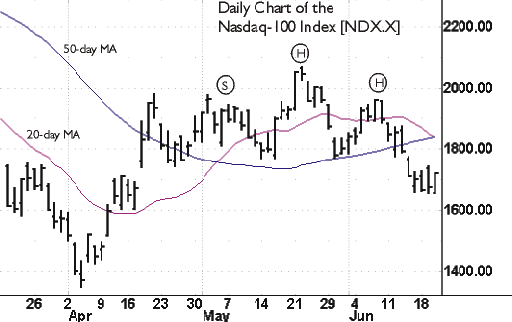
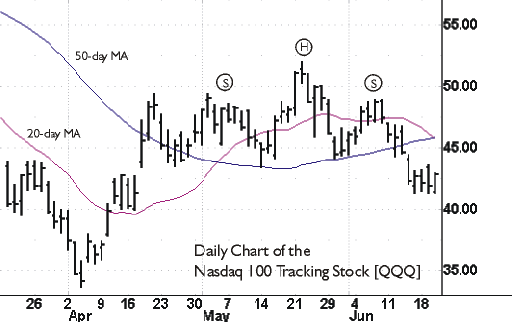
Head and shoulders
pattern in index is mimicked almost exactly in the tracking stock.
Basic
strategies
Daytrading
with the Q’s
Daytrading with the Q’s can be a
pretty straightforward affair. Whatever your style may be, you can take
advantage of the tracking stock and apply your preferred methodology to it. I
like to approach daytrading with this instrument in two ways:
- Look for a bullish or bearish bias
in a bigger-picture pattern on the daily and weekly charts
OR
-
Look for a two- to
five-day pattern indicating a change in direction or continuation
In both cases, you will
key on the following day for an entry point on your intraday chart.
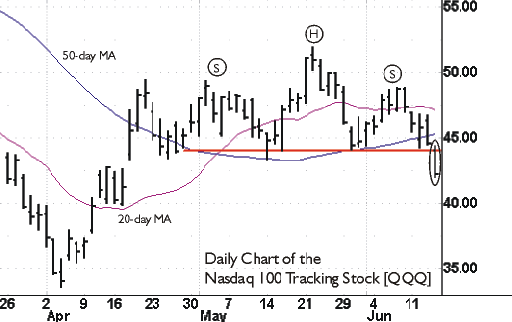
Here we have a head-and-shoulders
pattern that has formed on the daily chart, and the weekly is showing a
downtrend since September, 2000. We are looking for a break of the neckline on
June 14. The subsequent trading gives up a couple of pattern entries on that
day, a breakdown from a mini head and shoulders and a bounce off the 50%
retracement of the intraday high to low.

Swing
Trades
I try to keep my swing
trading approach, for the most part, the same as for daytrading. The only change
is the focus on the time frame — now I am looking for a pattern to catch a two-
to five-day move.
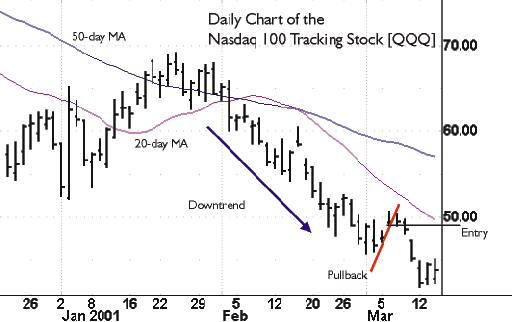
This simple pullback in a
month-long downtrend allows swing traders to catch the bulk of a move to the
downside of more than 7 points over four days.
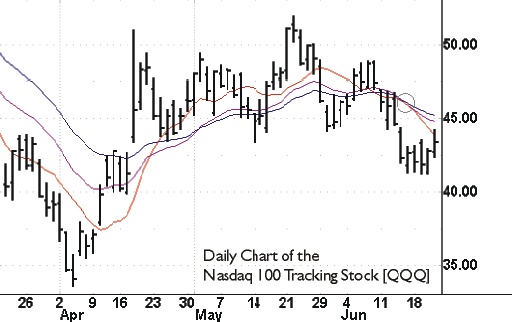
The stock is now forming
a Bow
Tie. This has yet to play out, but is a good example of the patterns swing
traders will find in the Q’s.
Intermediate-term
Trades
Since the many
intermediate-term traders do not take on short positions, it is hard to find
recent examples of a good intermediate-term setup, since the trend has been down
and no real base has been built in the Q’s. However, the approach in this
vehicle is the same as it will be for any intermediate-term trade in another
stock. Most will be on the lookout for a basing formation, accompanied by
improving market dynamics and a breakout on a substantial increase in volume.
Those who do play the short side may find the current inverted cup-and-handle /
head-and-shoulders interesting.
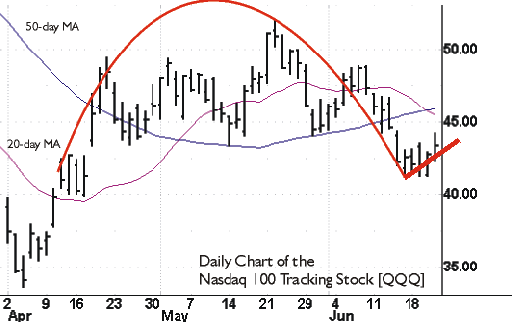
This second part of a
three-part series was a basic look at some of the ways you can implement
fundamental strategies into trading this instrument.
In the
final installment,
we will take a more advanced look at some of the methods TradingMarkets.com
contributors Kevin
Haggerty, Goran
Yordanoff, Carolyn
Lueck, Alan
Farley and the guru of the Q’s, Don
Miller, employ in their own trading, using this versatile issue.
Until then, best of luck
with your trading, everyone.
For The Best Trading
Books, Video Courses and Software To Improve Your Trading
